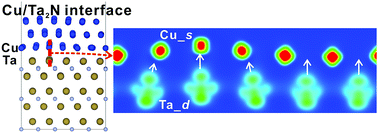Chemical bonding and Cu diffusion at the Cu/Ta2N interface: a DFT study†
Abstract
Ta2N is an effective diffusion barrier material to prevent undesired Cu diffusion in ultra-large scale integration circuits. Previous theoretical work has reported the interesting result that at the Cu/Ta2N interface the Cu layer preferentially bonded with the Ta layer but not the N layer of Ta2N. However, this result was calculated from largely lattice mismatched interface models. To confirm this theoretical result and unravel the cause of strong Cu–Ta bonding at the Cu/Ta2N interface, in this study density functional theory calculations, on the basis of super-cell models, were performed to investigate the Cu(111)/Ta2N(001) interface. We firstly calculated interface cohesive energies and confirmed that the Cu layer preferentially bonded with the Ta layer of Ta2N. Then, electronic structure calculations revealed that the chemical bonding of the Cu–Ta bond at the Cu(111)/Ta2N(001) interface was primarily covalent in character, providing a proper explanation for the close integration of the Cu layer and Ta layer. Lastly, Cu diffusion investigations revealed that Ta2N was able to effectively prevent Cu diffusion. Furthermore, we found that the N layer of Ta2N played the critical role in preventing Cu diffusion.



 Please wait while we load your content...
Please wait while we load your content...